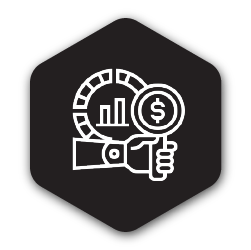From one angle, market data can appear a daunting and vague term. That's especially true if you don't understand or know much about it. From another, it can seem overly complex and downright confusing. But once you start to figure out how this critical data type interacts with your business, you'll begin to understand the role this information plays in the retail environment.
Once you do, you will soon realise that you can achieve a lot more success by using it than you'd expect.
Ignoring market data can prove costly too. Don't believe us? Here's a quick breakdown of the risks associated with not understanding this data type. You could struggle with any or all of these consequences:
- Missed opportunities in the market;
- Misunderstanding your consumers;
- Offering the wrong products; and
- Overstocking or running out of stock.
There are many more risks than the above ramifications, but this isn't about what can go wrong without retail market data. Instead, this article is about what can go right when you put your market data to work for you. We examine the three assessments that you can complete and explore how they will help provide you with a better understanding of why it's not only critical to analyse your data but also the benefits.

1. You can assess the market
With market data at your disposal, the first (and obvious) assessment you can complete is the (external) market assessment.
A market assessment is a detailed macro analysis you can do to understand your position in the market, establish a need or a demand for a product offering and identify opportunities.
When analysing the market, you can look at a few different criteria:
- Your competitors: What do they offer?
- Your customers: Who are they? What do they buy? Why do they buy?
- Your product offering: Does it match what your customers want?
Let's unpack each in more detail. We'll go bottom to top, beginning with your product offering.
By analysing your market, you can identify gaps. You can then explore whether you can fill these gaps. Identifying these opportunities and acting on them means you could eventually lead the market in a specific product offering and bring in new customers. You might even be able to entrench the belief in others that you are the store to visit if they need a specific range of products.
Then there is the point about your customers.
In looking at the market and examining its needs, ebbs and flows, you can analyse what your customers are buying within your different clusters. Doing so enables you to determine if you have placed products in the correct market. If you find that a product isn’t selling and it should belong in a specific region or area, you can remove it before adjusting your product range accordingly.
Lastly is the competitor analysis.
You can identify the number of competitors you have, which will help you decide on the pricing of your products.
If you have limited competition, you are free to price your products as you want. When you have more competitors, you will have to be strategic with your pricing.
You have to price your products competitively to ensure consumers buy yours and not your competitors’ products.
You can also identify market trends. This will reduce the risk of entering a market that might not be ready for your product offering.
It’s worth pointing out that a market assessment can also help you determine your category captains, which could lead to a better relationship with your suppliers.
 2. You can assess the consumer
2. You can assess the consumer
The second outcome you can achieve is to complete a consumer assessment.
A consumer assessment involves analysing data about your current or future customers. You want to understand who they are, what they buy, why they buy, when they buy, and where they buy.
When analysing a customer and or potential customer, it’s critical to look at the customer psychology. That includes uncovering their shopping patterns, LSM, demographics and lifestyles.
After assessing your customers, you can set up clusters for your business and group people who shop the same within the same cluster, boosting your revenue.
In setting up clusters in different regions, you can build accurate assortment plans, which will be personalised to your specific clusters. This will lead to increased sales since you provide your customers with more of what they want and need when they are looking for it.
Assessing your consumer and ensuring you understand them will reduce risks and carry a few benefits to your company. Benefits include, amongst others:
- Offering the right products at the right time;
- Holding the correct amount of stock to meet demand; and
- Reduce the risk of out of stocks/overstock situations.
Then there is the point that you can provide a more personalised customer experience in-stores. Achieving this hyper-personalised leads to increased customer loyalty. That’s good for a couple of reasons including the point that it can drive differentiation in retail.
By understanding your data, you can better understand the purchasing behaviour of your customers. In doing so, you can find out if they are more loyal to certain brands or if they are ‘convenience’ customers.
 3. You can assess the category
3. You can assess the category
The final appraisal is your category assessment or analysis.
A category analysis takes a deep dive into your product groupings to interpret them and determine whether stocking each either boosts or hinders your business.
When analysing a category, amongst other factors, you can consider the following:
- Display hierarchy;
- Consumer decision tree (CDT);
- Sales and Units; and
- Category role, tactics and strategies
Here’s a closer look at each.
Display hierarchy and CDT
Looking at your display hierarchy and consumer decision tree, you can establish the type of products to merchandise under your category. This ensures that it not only makes sense to you but also to your consumer.
Having items together that make sense could lead to increased sales. For example, placing baby bottles with baby caps could increase the chances of a cap being purchased with the bottles. However, stocking baby bottles next to sugar will only cause confusion.
Sales and Units
By analysing your categories' sales and units’ data efficiently, you can identify the bestselling sub-categories, brands, individual products, as well as the worst-selling ones.
Having this information at hand with your market and consumer assessment, you can build an assortment plan with items and specific brands that sell. Meanwhile, you can remove the items that do not sell.
Another benefit of looking at your categories' sales and units’ data is allowing you to do sales forecasting.
By analysing your category over a few seasons/years, you can spot trends and predict which sub-categories will sell when.
The final benefit of your sales and units data is that you can allocate the correct shelf space to your category and sub-categories. Being able to give your category and subcategories the right amount of space in your different clusters leads to your desired stock turnover in stores.
Category roles, tactics and strategies
Understanding the category role - Destination, Seasonal, Convenient or Routine - allows you to:
- Do the right type of marketing at the right time;
- Place your product in the right type of store;
- Merchandise your stores accordingly;
- Place the category in the right region for the right customers and
- Check if you have classified your category correctly.
For example, if you have a seasonal product/category but originally classified it as a destination-type category, your consumer will be disappointed when they come to your store and find that the product is not available as it is only in-store once a year.
Meanwhile, you can determine if you have chosen the right tactics and strategies for your sub-category or if you need to re-evaluate your sub-categories, its roles, tactics, and strategies to ensure that it sells where you have placed it.
If a product is not selling with the tactics and strategies allocated, you can investigate it, evaluate your category and allocate a new tactic to it to see if you can help your category grow. All this is possible because you understand the data at your disposal.
There are four different tactics that you can use in your categories - also referred to as the 4 P’s of Marketing:
- Pricing
- Placement
- Merchandising
- Promotion
These tactics are effective and easy to swap out. If, for example, the pricing for your category is not working, you can try promotion to increase sales and product movements. Likewise, if your placement isn’t working, you can try a different tactic. By switching up various tactics and comparing performances, you can gauge which ones work best and when.
By doing a category assessment, you can also establish your known value items (KVIs) and price and position them accordingly. KVI’s are products that are mostly compared to other brands by your consumer and, incidentally, also the products that bring in most of your revenue.
Knowing your KVI’s can ensure that you price, place and promote them at the right time, thereby beating out your competition.
Conclusion
As a retailer, it’s critical to assess your market, consumer, and categories. Completing these assessments not only helps you to understand retail business from a macro level but also at a micro-level. You can learn about all the details and elements that help make your business successful.
As a supplier, having a detailed and factual report on the market, categories and consumers can boost your relationship and collaboration with your retail client and allow you to place your products in their stores with the space they really deserve. It’s a win-win.
It will help you find opportunities and help you build the right product for the right consumer at the right time and place.
About the contributors
Chanelle Jacobs joined DotActiv in 2021 as a space planner on various accounts. She has since moved to the role of account manager for JB Active. She has a Bachelor of Consumer Science with Business Management from North-West University.
Nadia Duvenage joined DotActiv in late 2020 as a space planner to work on a variety of our ad-hoc accounts including Indigo Brands, Pioneer Foods and Vital. She has since joined our Food Lover's Market account as a category planner. She has a Bachelor of Commerce (Honours) in Marketing from Stellenbosch University.
Palesa Mnguni joined DotActiv in 2021 as a space planner on our ad-hoc accounts where she delivers a variety of category management services, including data-driven planograms. She has a Bachelor of Commerce (Honours) in Strategic Management from the University of Johannesburg.


